In January the maps rolled out. Maps of the Bob appear on the kitchen table when the days grow short and the trails icy. After crossings by different routes of roughly 50 miles each the past two summers, was it possible to create another route of similar distance and matched scenery? Would anyone ante up for it? Was it possible to hoodwink drivers for another long shuttle circumnavigating a huge swath of the northern Rockies?
 |
| Credit: Vo von Sehlen |
Over the last three years, the run we now affectionately know as “RATBOB” has evolved to require just a few simple ingredients: Traverse some segment of the Bob Marshall Wilderness from one point to another, because who wants to run 50 miles just to end up back at the start? Revise the route each year because life is short, variety is good, and the Bob is big. Stretch it long enough to occupy an entire day, but short enough to avoid the risk of spooking grizzlies or skunks after dark. Reach high altitude a few times so to gaze over the endless ridges and marvel that there’s still something this enormous without roads or cell towers. Finish with a bunch of food and drinks and some time to tell stories. Manufacture a catchy acronym. That seems to be enough to entice just enough goofballs to sign on, but not so many as to lose respect for the sacredness of this place. After that, it’s just pure fun.
Each of the three RATBOBs has crossed the Wilderness from east to west, starting somewhere along the Rocky Mountain Front before sunrise, then following the sun, over the Continental Divide to some obscure trailhead on the west side. This year’s route took us to a new start — Headquarters Pass in the upper reaches of the Teton River basin, and then meandered northwest to our exit point at the Silvertip trailhead on the Spotted Bear River.
Once the route is roughed out, the logistics are simple. Send some enticing emails, pass the word, and buy a bunch of food and beer. By the end of May I had a list of nearly 40. By launch date we were down to about 20 runners, which is about the perfect number because it allows us to divide into small manageable groups but still be there to support each other. The key ingredient is the support crew and that’s where Missoula shines. To run this 50-odd mile boondoggle required a shuttle of over 600 miles. That’s a good thing because it’s a tribute to just how little road access there is in the divide country between Glacier and Roger’s Pass (none).
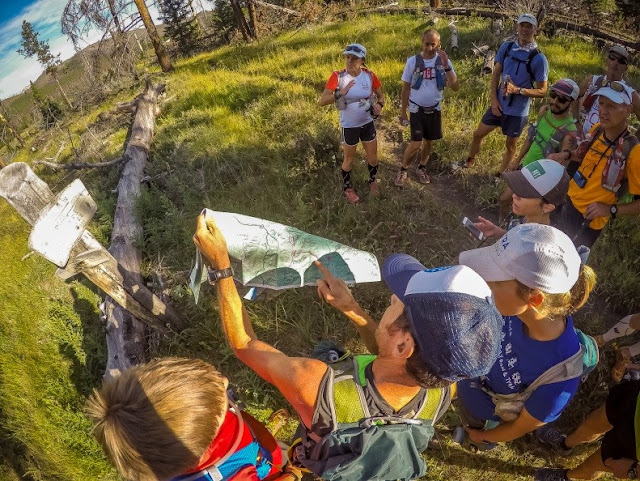 |
| Credit: Vo von Sehlen |
The Gang
Among the many things to love about this run is the assortment of people who end up at the start and how they all get connected. There were the three-peat veterans, names synonymous with Missoula running – Ken Ellis, Dean McGovern, Tim Mosbacher and Jared Oyler. Each of these guys now has run over 150 miles in the Bob over the last three summers. Several others who always are up for trail adventures all year long – Justin Grigg, John Fiore, Allison Onstad, Renate Bush, Mark Munro, Vo von Sehlen, Tod Bachman and of course JB Yonce. Others who got word second or third hand and took the plunge – Joran Elias, Erin Clark, Sally Cannata, and Milton Zhinin. Rounding out the runners were two medical residents new to town, but very accomplished runners Christi Nowak and Ethan Richards. And most importantly, the support crew (more on them later).
Following the tradition of the last three years, we caravanned out of Missoula early Friday afternoon. We headed first to the mandatory stop at the Buckhorn Bar in Augusta to see if they’d run out of chicken dinners yet (they hadn’t). We next stopped briefly in Choteau for supplies, gas, and a glimpse at the fiddlers in the back of a semi, then turned west toward the jagged line of peaks that form the Rocky Mountain Front.
Headquarters Pass By the Dawn’s Early Light
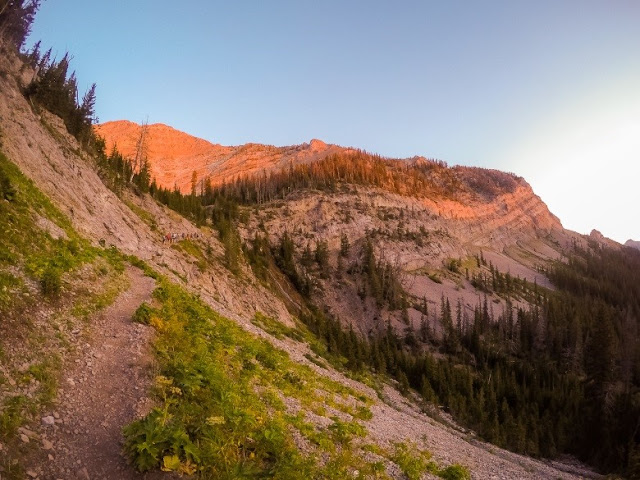 |
| Credit: Vo von Sehlen |
Thirty miles west of Choteau, the road up the South Fork of the Teton River dead-ends hard against the aptly-named Sawtooth Range. From the air (or in my case, hours spent manipulating Google Earth), the Sawtooths are a series of massively layered rocks tilted west and sheared off in jagged faces to the east. Sort of like someone shoved a stack of books up a ramp. A geologist would call it imbricate thrust faulting. Everyone else calls it stark, beautiful and slightly daunting when approached from the east. It’s almost impossible to enter the mountains more dramatically.
After crawling out of our little Forest Service campground in the dark, we were at the trailhead by 5:00. We counting noses, switched on headlamps and immediately began to climb up one of the steep eastern faces. By 6, the sun rose out of the eastern plains. Its long rays bathed the barren mountains above us with soft pink light. With each turn the terrain became more tundra-like with only rocks, flowers and scrawny wind swept krummholz. After 2000 feet of steady climbing, we reached Headquarters Pass. The pass is a rocky notch that sits between two mountains – Rocky Mountain to the south and Old Baldy north. Rocky Mountain is the highest peak in the Bob and earns its rather bold name.
Five of the support crew joined us for the trudge up Headquarters Pass. After snapping some pictures, they shoved us over the edge to the west and turned back for their long loop up around Marias Pass and down the long Hungry Horse road. The rest of us now were committed to do whatever it took to get all of us across the next 45 miles, most of which none of us ever had seen.
From Headquarters Pass the trail drops into a long gradual valley that was scorched in the legendary 1988 fires and still bears its scars in silvery snags surrounded by vibrant adolescent new growth. Nine mountain goats greeted us, climbing the trail we were descending. The next 8 miles or so were very smooth and runnable and we quickly spread out as the air grew warm. Some of us began to feel the early inking that this was going to be a long day.
 |
| Credit: Vo von Sehlen |
At 12 miles we reached the bottom of Headquarters Creek where it dumps into the North Fork of the Sun. At that point we’d given back all the elevation we’d earned and now actually were at the lowest point of the whole run. We regrouped and crossed the North Fork of the Sun on a sturdy horse bridge and entered the series of meadows that form Gates Park. Gates Park is classic Bob Marshall country – wide grassy valleys filled with rich tall grass, surrounded by mountains on all sides. The Sawtooths now rose behind us to the east, the main spine of the Continental Divide our next destination to the west. Any other place in Montana the valley would be filled with cows and the cows would be in heaven. But there were no cows, nor other people, so we got that little slice of heaven all to ourselves, just like we did for most of the rest of the day.
The North Wall
From Gates Park we began our second big climb of the day, this time a long 8 mile, several thousand foot slog up Red Shale Creek. It now was mid-morning and warm. Again we spread out in little groups of threes or fours. The Red Shale drainage burned in 2013, during the first RATBOB run. Unlike the fire remnants in the run down from Headquarters Pass, these scars still are fresh. Trees jet black with soot and ashy soil underfoot. But the open vistas were great and there was pink fireweed everywhere. I had worried that this drainage would be hot and dry, but the more we climbed the more lush it became.
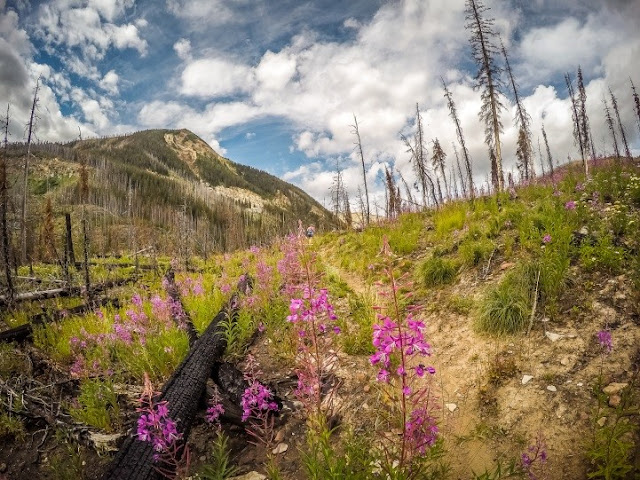 |
| Credit: Vo von Sehlen |
After about 7 miles of climbing, the trail grew steep, but we also reentered shady unburned forest, so it didn’t seem so bad. The trail slowly switchbacked up until we finally broke out into a beautiful meadow filled with flowers and backdropped by the huge yellow escarpment that forms the North Wall. It now was after 11:00 and we’d become pretty spread out, so we stopped for a long lunch break to regroup. The clouds gathered heavy on the wall and spit rain and the wind blew. No one said much about the weather, but it was on our minds, especially with only 20 miles down and more than 30 to go.
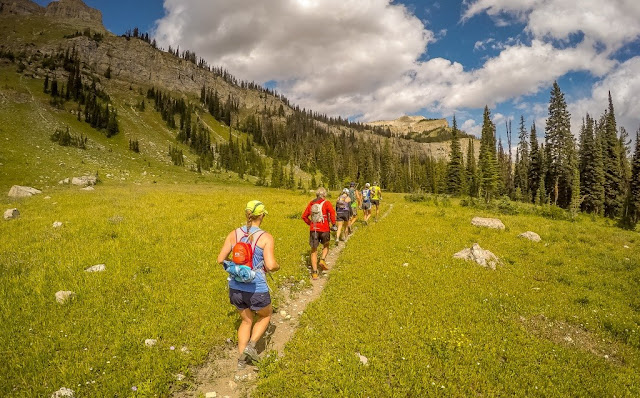 |
| Credit: Vo von Sehlen |
Every good run seems to have a heart and for this run the heart was the run along the North Wall. Up to Red Shale Meadows we’d mostly been traveling west, but now we turned north. The North Wall was our companion for 12 stunning miles after leaving Red Shale Meadows. It’s much wilder than the Chinese Wall, and every bit as spectacular. Like the Chinese Wall, the crest forms the Continental Divide. Our trail at its base is part of the rugged Continental Divide Trail that runs from Canada to Mexico.
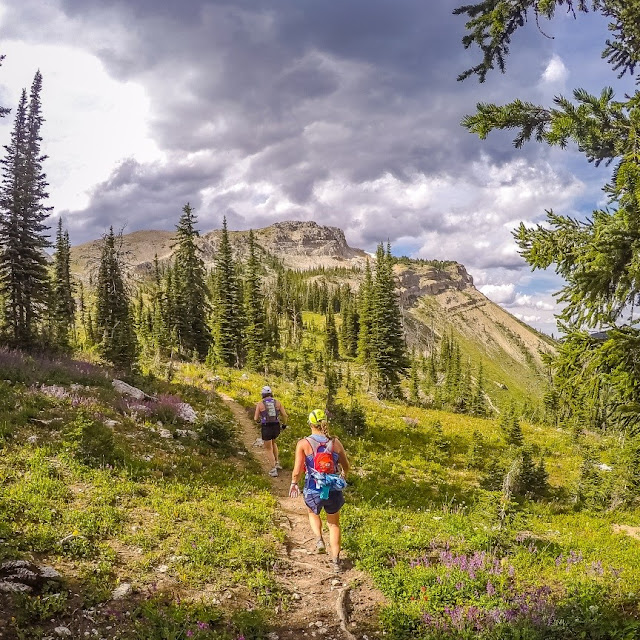 |
| Credit: Vo von Sehlen |
 runwildmissoula.org >>
runwildmissoula.org >>